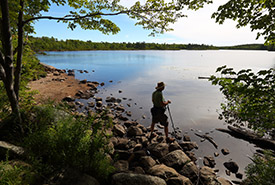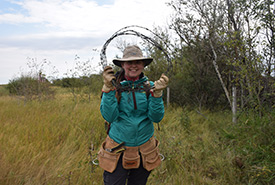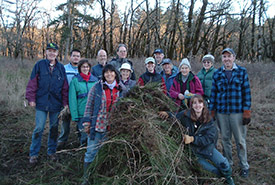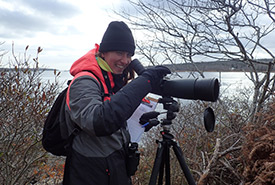Healthy by nature: Improve your health by giving time to conservation and nature

Research shows that spending time in nature benefits us both physically and mentally. (Photo by Mike Dembeck)
Research shows that spending time in nature benefits us both physically and mentally. Just taking a walk in a forest can regulate blood pressure, boost mental health, lower the risk of cancer, and reduce stress and inflammation in the body. Volunteering also produces an increase of feel-good hormones in the brain. When you combine the two, getting outside and volunteering for conservation may be exactly what the doctor ordered to improve your overall mental and physical health.
The Nature Conservancy of Canada’s (NCC’s) Conservation Volunteers program is a great way to get outside and participate in hands-on conservation work. Check out opportunities across the country — from butterfly surveys to invasive weed pulls to tree plantings. There’s something for everyone!
Here are some ways to get outside with NCC, improve your health, and that of nature.
Get moving

Conservation Volunteers events can be physically active, as participants walk around the property, pull invasive plants, clean up shorelines or remove old fences. (Photo by NCC)
Conservation Volunteers events can be physically active, as participants
walk around the property, pull invasive plants, clean up shorelines or remove old fences. They are a great way to get moving while making a difference for the environment. One NCC volunteer claims “Participating in the Conservation Volunteers program is a ‘Triple E’ experience — education for the mind, exercise for the body and enrichment for the spirit.”
Are you ready to get moving?
Join us this year in the Red Deer region of Alberta for the third and final fence pull on the Collins property. This 63-hectare (155-acre) property is home to an abundance of waterfowl as well as mule deer, coyote, moose and red-tailed hawk. This event will help reduce the risk of injury to wildlife from old barbed-wire fences.
Near the start of summer, we will also be removing a fence and hosting a bioblitz at our Hole in the Wall property, in southwest Saskatchewan. This property was recently acquired by NCC and features a beautiful section of grassland. It is part of the largest intact grassland in Saskatchewan, and home to species at risk, such as burrowing owl, American badger, ferruginous hawk and the prairie population of the northern leopard frog.
Join a community

"I was impressed with the sense of community and the gathering of people with a common goal to contribute to the greater good of nature and wildlife." (Photo by NCC)
Connecting with like-minded individuals through volunteering can help build community. Attending events is a great way to make new friends and grow your social network. “I was impressed with the sense of community and the gathering of people with a common goal to contribute to the greater good of nature, wildlife and the environment,” says one NCC Conservation Volunteer.
Sign me up!
NCC’s British Columbia Region hosts weekly Weedy Wednesdays events at the Cowichan Garry Oak Preserve. This is a great opportunity to get your hands dirty, learn restoration tips and tricks from long-time volunteers and become part of a welcoming community of nature lovers and restoration experts.
Become a citizen scientist

Participating in citizen science initiatives can help you learn new things and allow you to contribute your knowledge. (Photo by NCC)
Participating in citizen science initiatives can help you learn new things and allow you to contribute your knowledge. Immersing yourself in an activity that requires your time and talents can provide a sense of accomplishment. The experience also lets you focus on the task at hand and help others.
NCC offers opportunities to get out on the land and contribute to ongoing science initiatives. For example, the annual Port Joli Wild for Waterfowl event in Nova Scotia gives volunteers the chance to survey bird life within the 40-kilometre-long Important Bird and Biodiversity Area. The data is then submitted to the Canadian Wildlife Service and eBird, and is used by NCC to inform management decisions.
Sound intriguing?
A dedicated volunteer had this to say after participating in last year’s event: “Volunteering for this event allowed me to see and learn about waterfowl in an Important Bird and Biodiversity Area, and contribute to long-term monitoring of the species using it. Not only did I learn, I obtained physical exercise and got outside, close to nature — something essential to my mental health.”
This story first appeared in the spring 2019 issue of the Nature Conservancy of Canada Magazine. Donors who contribute at least $25 or more per year will receive four issues of the magazine. Click here to donate today and start receiving the magazine.




